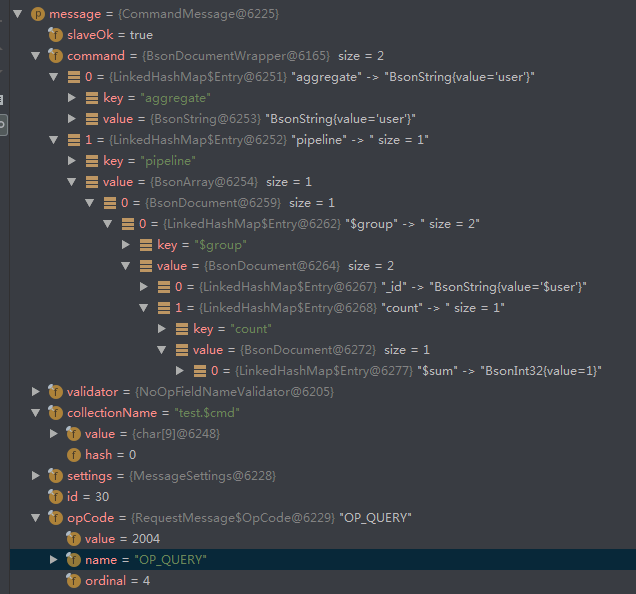spring-data-mongodb与mongo shell的对应关系
除了特殊注释外,本文的测试结果均基于 spring-data-mongodb:1.10.6.RELEASE(spring-boot-starter:1.5.6.RELEASE),MongoDB 3.0.6
上一章我们了解了mongo shell中aggregate复杂的互相调用关系。那么,spring-data-mongodb中aggregate又是如何与mongo交互的?是将语句拼接成我们熟悉的函数(db._collection_.find/update...)还是命令(db.runCommand)?让我们来看底层的代码到底是怎么样的。
以下为 mongoTemplate.aggregate 方法的底层实现
private void sendMessage(final CommandMessage message, final InternalConnection connection) { ByteBufferBsonOutput bsonOutput = new ByteBufferBsonOutput(connection); try { int documentPosition = message.encodeWithMetadata(bsonOutput).getFirstDocumentPosition(); sendStartedEvent(connection, bsonOutput, message, documentPosition); connection.sendMessage(bsonOutput.getByteBuffers(), message.getId()); } finally { bsonOutput.close(); } }
在往下就是字节流了,就直接看着里的数据吧,message数据为:

test是连接的数据库名称,test.$cmd相当于db.$cmd,有过第二章的基础,这里应该明白,这个方法是走runCommand的$cmd集合的。那么相应的 mongoTemplate.getDb().command 以及 mongoTemplate.getCollection("$cmd").findOne 都可以拼接出来。
因为这些方法需要的拼接很复杂的bson,所以这里我们引用另外一个操作符$eval。熟悉js的朋友应该都知道,eval是可以将字符串转换成方法执行的,这里我们就使用原生的aggregate语句字符串,让mongo shell去处理字符串。
如下是五种使用$eval的方法
//注意:命令的key:value部分,value必须被[]或者{}或者''包裹。js的字符串支持单引号和双引号两种,这里使用单引号是为了避免在java中使用大量的 \
String command = "db.user.aggregate([{$group:{_id:'$name',count:{$sum:'$age'}}}])";
BasicDBObject bson = new BasicDBObject();
bson.put("$eval",command);
Object object1 = mongoTemplate.getDb().doEval(command);
Object object2 = mongoTemplate.getDb().command(bson);
Object object3 = mongoTemplate.getCollection("$cmd").findOne(bson);
ScriptOperations operations = mongoTemplate.scriptOps();
ExecutableMongoScript script = new ExecutableMongoScript(command);
Object object4 = operations.execute(script);
/**
* call是调用system.js集合中方法的方法,传入参数是sysytem.js表中数据的主键值,
* 可在mongo shell中天插入或者使用如下代码插入。
* 插入一次后可直接使用
*/
// String command = "function(){return db.user.aggregate([{$group:{_id:'$name',count:{$sum:'$age'}}}])}";
// NamedMongoScript namedMongoScript = new NamedMongoScript("user2",script);
// operations.register(namedMongoScript);
Object object5 = operations.call("user2");
那么,find函数是否也如mongo shell 中,让我们继续来看看底层代码
private <T> List<T> executeFindMultiInternal(CollectionCallback<DBCursor> collectionCallback, CursorPreparer preparer, DbObjectCallback<T> objectCallback, String collectionName) { try { DBCursor cursor = null; try { cursor = collectionCallback.doInCollection(getAndPrepareCollection(getDb(), collectionName)); if (preparer != null) { cursor = preparer.prepare(cursor); } List<T> result = new ArrayList<T>(); while (cursor.hasNext()) { DBObject object = cursor.next(); result.add(objectCallback.doWith(object)); } return result; } finally { if (cursor != null) { cursor.close(); } } } catch (RuntimeException e) { throw potentiallyConvertRuntimeException(e, exceptionTranslator); } }
我们可以看到find也如mongo shell中一样,走的是游标的路线。
通过上面的一系列代码的研究,我们学会了使用多种方法实现原生的aggregate,并且弄明白了aggregate在mongo shell 或者spring-data-mongodb中都存在多层的、暴露的调用方法,而find类型的请求是直接调用到了游标,这样设计的目的是什么?有兴趣的读者可以继续看看第四章 mongo中的游标与数据一致性的取舍。
目录
一:spring-data-mongodb 使用原生aggregate语句




 浙公网安备 33010602011771号
浙公网安备 33010602011771号